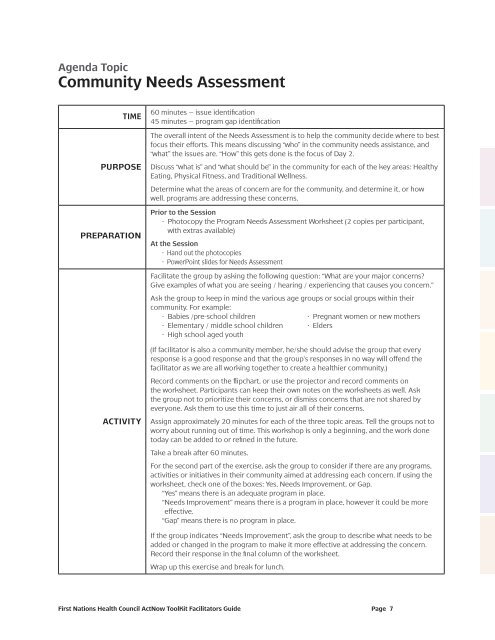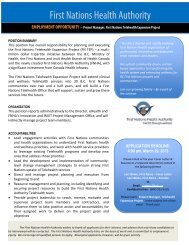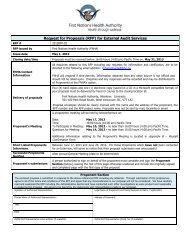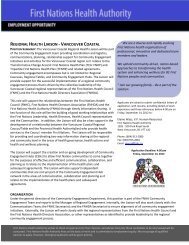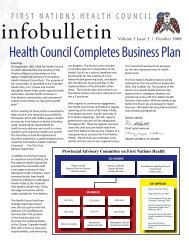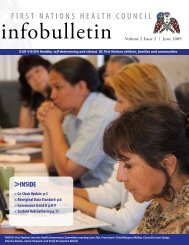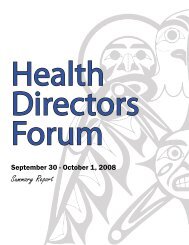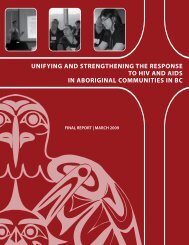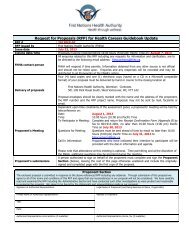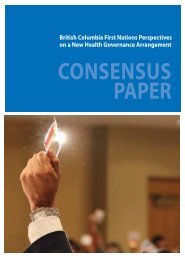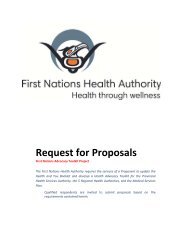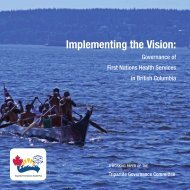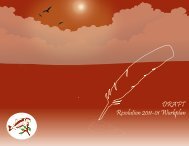actNow Toolkit Facilitators Guide - First Nations Health Council
actNow Toolkit Facilitators Guide - First Nations Health Council
actNow Toolkit Facilitators Guide - First Nations Health Council
- No tags were found...
You also want an ePaper? Increase the reach of your titles
YUMPU automatically turns print PDFs into web optimized ePapers that Google loves.
Agenda TopicCommunity Needs AssessmentTimePurposePreparationActivity60 minutes – issue identification45 minutes – program gap identificationThe overall intent of the Needs Assessment is to help the community decide where to bestfocus their efforts. This means discussing “who” in the community needs assistance, and“what” the issues are. “How” this gets done is the focus of Day 2.Discuss “what is” and “what should be” in the community for each of the key areas: <strong>Health</strong>yEating, Physical Fitness, and Traditional Wellness.Determine what the areas of concern are for the community, and determine it, or howwell, programs are addressing these concerns.Prior to the Session• Photocopy the Program Needs Assessment Worksheet (2 copies per participant,with extras available)At the Session• Hand out the photocopies• PowerPoint slides for Needs AssessmentFacilitate the group by asking the following question: “What are your major concerns?Give examples of what you are seeing / hearing / experiencing that causes you concern.”Ask the group to keep in mind the various age groups or social groups within theircommunity. For example:• Babies /pre-school children• Pregnant women or new mothers• Elementary / middle school children • Elders• High school aged youth(If facilitator is also a community member, he/she should advise the group that everyresponse is a good response and that the group’s responses in no way will offend thefacilitator as we are all working together to create a healthier community.)Record comments on the flipchart, or use the projector and record comments onthe worksheet. Participants can keep their own notes on the worksheets as well. Askthe group not to prioritize their concerns, or dismiss concerns that are not shared byeveryone. Ask them to use this time to just air all of their concerns.Assign approximately 20 minutes for each of the three topic areas. Tell the groups not toworry about running out of time. This workshop is only a beginning, and the work donetoday can be added to or refined in the future.Take a break after 60 minutes.For the second part of the exercise, ask the group to consider if there are any programs,activities or initiatives in their community aimed at addressing each concern. If using theworksheet, check one of the boxes: Yes, Needs Improvement, or Gap.“Yes” means there is an adequate program in place.“Needs Improvement” means there is a program in place, however it could be moreeffective.“Gap” means there is no program in place.If the group indicates “Needs Improvement”, ask the group to describe what needs to beadded or changed in the program to make it more effective at addressing the concern.Record their response in the final column of the worksheet.Wrap up this exercise and break for lunch.<strong>First</strong> <strong>Nations</strong> <strong>Health</strong> <strong>Council</strong> ActNow ToolKit <strong>Facilitators</strong> <strong>Guide</strong> Page 7


